In the “before times”, a classic
whip-up-three-courses-in-a-pastoral-location type of cooking class was enough.
No longer. Courses that involve getting your hands down and
dirty with ingredients are becoming more popular with travelers who are looking
for culinary experiences that feel more primal — less sautéing in the foothills
of Florence and more grinding farce for sausages.
اضافة اعلان
Part of the allure is a deeper connection with food: They are
looking for transparency about where and when products are harvested and how to
source them so that they consume fewer plastic-wrapped foodstuffs of unknown
origin.
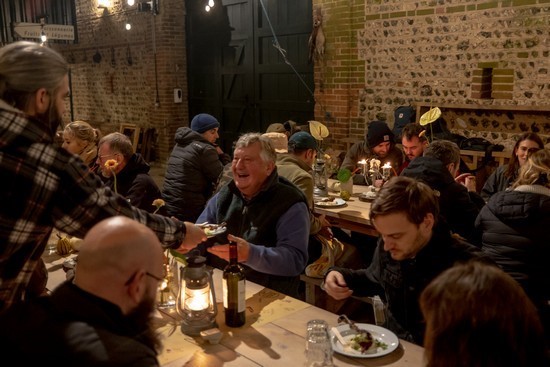 Culinary class attendees eat a meal of foods that they have
butchered and foraged on site at Firle Estate in Sussex, England on November 12,
2022.
Culinary class attendees eat a meal of foods that they have
butchered and foraged on site at Firle Estate in Sussex, England on November 12,
2022.
While there are no hard numbers on the trend, Emily Fitzroy, the
owner of Bellini Travel, which specializes in Italy, has seen a spike in
requests to learn a culinary skill while on vacation. “Clients want to return
home with newfound knowledge,” she said. Among the trips she has recently
booked: a deep dive into the world of offal.
Another tour operator, Black Tomato, is creating hands-on
“culinary moments” that deliver a greater understanding of the origins of food
by going directly to the source. One possibility is an afternoon on a
traditional 12m schooner in the Lofoten Islands of Norway, where participants
catch, clean and prepare cod, a vital source of revenue for the area.
And Hank Shaw, a James Beard Award-winning chef, cookbook author
and outdoorsman, offers three-day culinary hunts in Oklahoma, through his
company, Hunter, Angler, Gardener, Cook, and in partnership with Larry Robinson
of Coastal Wings Guide Service. In addition to hunting, the experience includes
learning skinning, plucking and other aspects of prepping game, including
waterfowl, so that participants no longer need to rely on commercial
processors. The $2,000 hunts (which include lodging, hunting and chef-prepared
meals) are announced in Shaw’s newsletter and, these days, sell out in 48
hours.
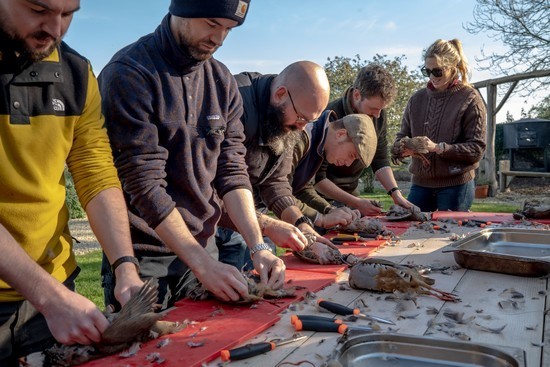 Culinary class attendees butcher partridge and pheasant at
Firle Estate in Sussex, England on November 12, 2022.
Culinary class attendees butcher partridge and pheasant at
Firle Estate in Sussex, England on November 12, 2022.
My quest for a deeper food experience led me to Nick Weston,
whose cooking courses in rural Sussex, England, involve game butchery and other
adventures with wild food.
A modern-day hunter-gatherer, Weston, 41, studied Mesolithic
cultures and archaeology in college, worked as a freelance chef, did a
three-month stint in the South Pacific as a “survivalist expert” for the
British reality show “Shipwrecked” (a UK iteration of “Survivor”) and then
retreated to his hometown of Sussex to live off the grid in a treehouse that he
built from recycled materials and to survive on what he could hunt, fish and
forage.
 A culinary class attendee carries partridge to
be cleaned at Firle Estate in Sussex, England on November 12, 2022.
A culinary class attendee carries partridge to
be cleaned at Firle Estate in Sussex, England on November 12, 2022.
Weston’s brand of bushcraft (chronicled in his blog-turned-book,
“The Treehouse Diaries: How to Live Wild in the Woods”) struck a chord with
people looking to connect with nature. So, in 2011, he created a cooking
school, Hunter Gather Cook, and began running full-day courses on butchery,
foraging, and fire-making from a new, middle-of-nowhere treehouse.
By the time my husband and I signed on for a course last summer
(a private one, since our schedule did not align with the group offering),
Weston’s headquarters had relocated to a 19th-century threshing barn in an
equally remote spot. The morning kicked off with us trudging up a gravelly path
shouting “Hello?” as we searched for signs of life beyond the scampering
weasels.
We crossed the threshold into environs that mixed elements of
Soho House hygge (exposed brick walls peppered with vintage signs, a potbelly
stove, and snuggly blankets) with supper club edge (leather apron-clad helpers;
a dining table tricked out with wax-clumped candelabra and plucked-from-the-earth
artichokes) and a pinch of Grimms’ Fairy Tales (displays of knives, axes, and
taxidermy). The Metallica-rich playlist augmented the atmosphere.
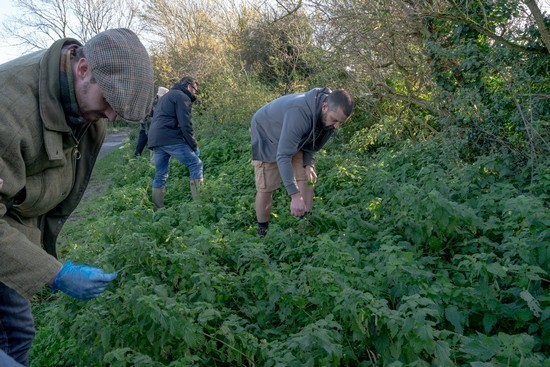 Culinary class attendees gather nettles at Firle
Estate in Sussex, England on November 12, 2022.
Culinary class attendees gather nettles at Firle
Estate in Sussex, England on November 12, 2022.
British wood pigeons were the first order of business.
Standing at a prep table set with the essentials — cutting
boards, knives, buckets — a member of Weston’s crew, who introduced himself as
Chops, told us where and when the birds, which were far more attractive than
the specimens in Chicago, my hometown, were shot and how the meat would be
cooked (deep-fried legs and pan-roasted breast) since preparation informs
butchery style. “Bone structure will be your guide,” he said, explaining that
we would mostly use our hands to break down the bird.
We lifted the gray-blue plumage to get a sense of the anatomy:
wings, breasts, breastbone, spine, legs, and tail. This all felt fine. Still, I
located an exit path in case my guts rebelled when the feathers began to fly.
The plucking was easy. You yank upward (against the grain) about
as hard as you would on a loose thread dangling from a T-shirt. Next, we made a
tiny incision in the chest and “released the skin” with our fingers until the
breasts were exposed. Still, no nausea. I found the exercise fascinating. Once
we snapped off the legs, excised the head and removed the wings, the remaining
meat resembled something you would see at the butcher shop.
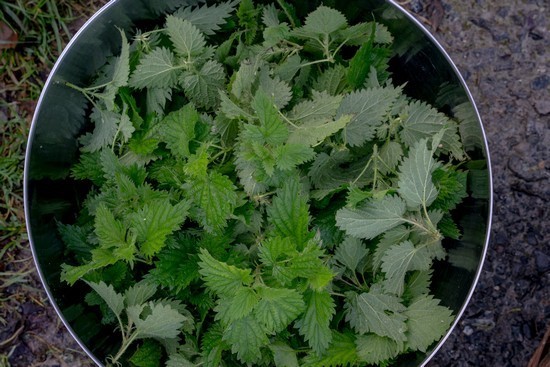 Nettles foraged by culinary class attendees at Firle Estate
in Sussex, England on November 12, 2022.
Nettles foraged by culinary class attendees at Firle Estate
in Sussex, England on November 12, 2022.
The removal of the entrails was a bit more gnarly. But once it
was done, we plunked the clean birds onto fresh cutting boards to inspect our
handiwork and ensure that there was no damage, such as broken bones or trauma
from the gunshots that had killed them. The meat was then handed over to the
chefs.
Curiosity had trumped squeamishness, and I felt flushed with
exhilaration. On to the rabbits. De-limbing a bunny is not for the faint of
heart. I dismissed thoughts of Beatrix Potter as I removed the feet, tail and
head before skinning the animal by making an incision at the belly and
loosening the hide with my hands and tugging it off. The area from the
shoulders to the hind legs is the saddle and contains the most tender pieces of
meat, so from there we trimmed out these fillets and meat from the back
haunches that would become part of our meal.
With the butchery complete, we swapped knives for wicker trugs
and headed out to forage for yarrow, nettles, wood sorrel, and meadowsweet,
some of which would also be infused into our meal. Southern England is a
mushroom paradise, but, sadly, we were too early to score the region’s
celebrated truffles and chanterelles.
About three hours had passed, and a pick-me-up was in order.
Back in the garden behind the threshing barn, snacks were
brought out along with a “wild” cocktail: foraged nettle gin gimlets that we
sipped through a borage stem straw.
“This is where the magic happens,” Weston said, pointing to a
hay-strewn fire pit that was flanked by a jumbo wood-fired oven and a homemade
clay oven.
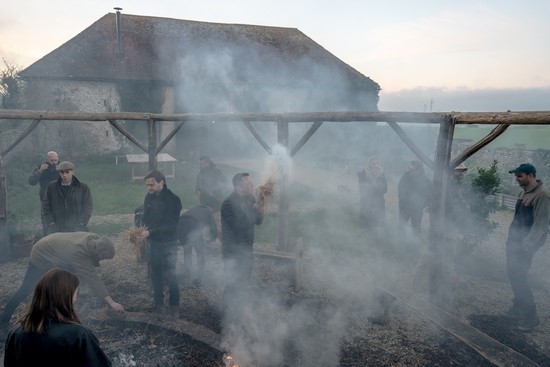 Culinary class attendees learn the basics of building a
fire using flint and tinder at Firle Estate in Sussex, England on November 12,
2022.
Culinary class attendees learn the basics of building a
fire using flint and tinder at Firle Estate in Sussex, England on November 12,
2022.
Initially, I was surprised that a course titled “Hunter Gather
Cook” did not actually involve participants’ cooking.
But as soon as I sat down to charred sourdough begging to be
dunked into gooey, baked, truffle-dusted Camembert (Weston’s dogs are truffle
hounds), I got it. It had been an intense few hours, and leaving the kitchen
duties to Weston’s team put a luxurious twist on the fruits of our labor.
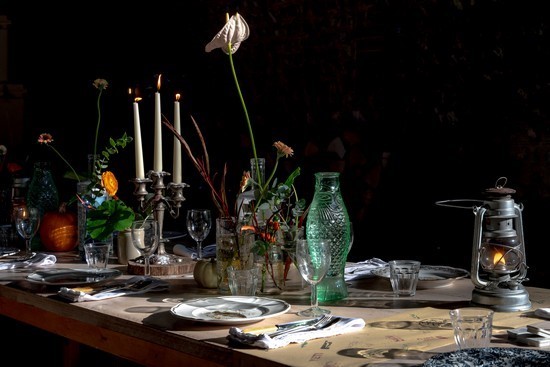 A table set for a meal prepared for culinary class attendees
from foods that they have butchered and foraged on site at Firle Estate in
Sussex, England on November 12, 2022.
A table set for a meal prepared for culinary class attendees
from foods that they have butchered and foraged on site at Firle Estate in
Sussex, England on November 12, 2022.
Wine flowed as the next two courses arrived: crispy hogweed
alongside deep-fried pigeon leg and smoked fallow deer tartare with a speckled
quail eggshell housing its sunny yolk. We sang along to Nelly and Travis Tritt
while the dishes kept coming: garden fresh gazpacho, cold smoked oysters
scented with fresh yarrow and sorrel, rabbit fillets atop a Caesar salad,
grilled rabbit haunch stuffed with pancetta-wrapped pigeon breast.
This was no rustic smorgasbord; it was a serious tasting menu
that told a story about how the seasonal, local products of this specific place
became the elegant plate of food before me.





